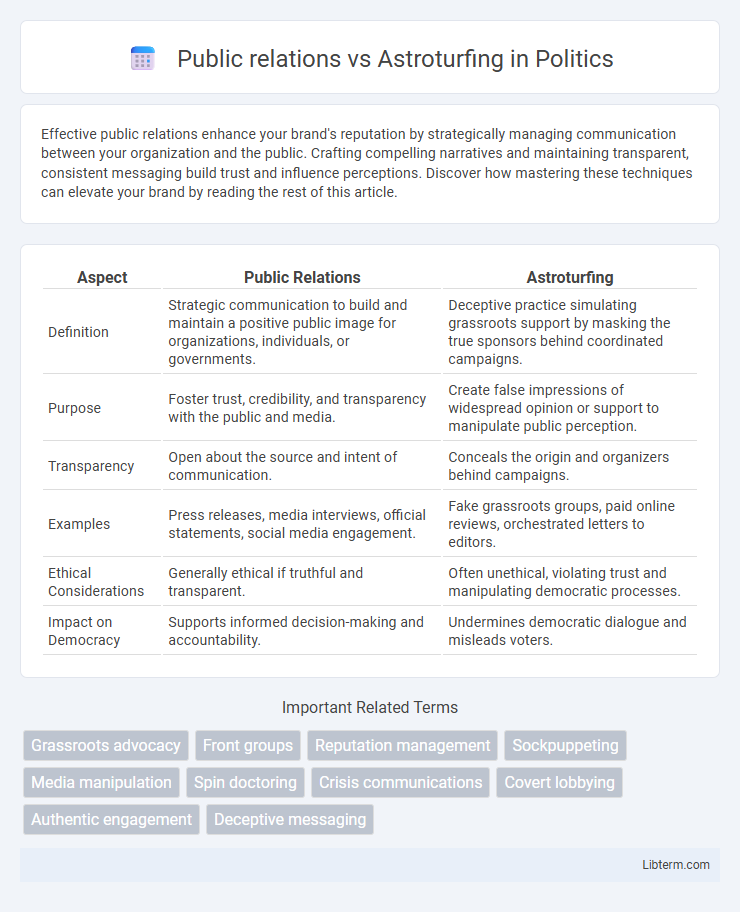Effective public relations enhance your brand's reputation by strategically managing communication between your organization and the public. Crafting compelling narratives and maintaining transparent, consistent messaging build trust and influence perceptions. Discover how mastering these techniques can elevate your brand by reading the rest of this article.
Table of Comparison
| Aspect | Public Relations | Astroturfing |
|---|---|---|
| Definition | Strategic communication to build and maintain a positive public image for organizations, individuals, or governments. | Deceptive practice simulating grassroots support by masking the true sponsors behind coordinated campaigns. |
| Purpose | Foster trust, credibility, and transparency with the public and media. | Create false impressions of widespread opinion or support to manipulate public perception. |
| Transparency | Open about the source and intent of communication. | Conceals the origin and organizers behind campaigns. |
| Examples | Press releases, media interviews, official statements, social media engagement. | Fake grassroots groups, paid online reviews, orchestrated letters to editors. |
| Ethical Considerations | Generally ethical if truthful and transparent. | Often unethical, violating trust and manipulating democratic processes. |
| Impact on Democracy | Supports informed decision-making and accountability. | Undermines democratic dialogue and misleads voters. |
Understanding Public Relations: Definition and Purpose
Public relations (PR) involves strategic communication efforts designed to build and maintain a positive public image for organizations, individuals, or brands. Its primary purpose is to foster trust, credibility, and mutually beneficial relationships with target audiences through transparent and ethical messaging. Unlike astroturfing, which disguises sponsorship to manipulate opinions, PR emphasizes authenticity and genuine engagement to influence public perception.
What is Astroturfing? An Overview
Astroturfing is a deceptive practice that involves creating the appearance of grassroots support for a cause, product, or policy when, in fact, it is orchestrated by organizations or interest groups. Unlike genuine public relations efforts that aim to build authentic relationships and trust with the public, astroturfing manipulates public opinion through fake endorsements, fabricated social media accounts, or paid protests. This tactic undermines transparency and misleads audiences by masking the true sources of influence.
Key Differences Between PR and Astroturfing
Public relations involves transparent communication strategies to build genuine brand reputation and trust, while astroturfing employs deceptive tactics to create fake grassroots support. PR relies on authentic engagement with stakeholders, whereas astroturfing manipulates public opinion through fabricated endorsements or anonymous campaigns. Ethical PR fosters long-term credibility, contrasting with astroturfing's short-term, misleading impact.
Ethical Implications: PR vs Astroturfing
Public relations (PR) emphasizes transparent communication and building genuine relationships with stakeholders, adhering to ethical standards that promote honesty and trust. In contrast, astroturfing involves disguising orchestrated campaigns as spontaneous grassroots movements, raising significant ethical concerns due to its deceptive nature and manipulation of public opinion. The ethical implications hinge on authenticity and accountability, with PR fostering open dialogue, while astroturfing undermines democratic processes by misleading audiences.
Authentic Engagement: Hallmark of True Public Relations
Authentic engagement in public relations fosters genuine connections through transparent communication, building credible relationships with audiences based on trust and honesty. In contrast, astroturfing manipulates public perception by creating deceptive grassroots campaigns that conceal the sponsor's influence, undermining authenticity. True public relations prioritize integrity and open dialogue, ensuring that stakeholder interaction is meaningful and ethically sound.
Deceptive Practices: How Astroturfing Operates
Astroturfing operates by creating the false appearance of grassroots support to manipulate public opinion, often using fake social media accounts, paid influencers, or fabricated testimonials. Unlike transparent public relations efforts that focus on honest communication and reputation management, astroturfing deliberately obscures its origins to deceive audiences and policymakers. This deceptive practice undermines authentic civic engagement and distorts democratic processes by presenting manufactured consensus as genuine public sentiment.
Impact on Public Trust: PR and Astroturfing Compared
Public relations fosters genuine communication that enhances public trust by promoting transparency and authentic engagement between organizations and their audiences. In contrast, astroturfing undermines public trust by creating deceptive, fake grassroots campaigns that manipulate opinions and obscure true public sentiment. The long-term impact of PR is strengthened credibility, while astroturfing risks damaging reputations and eroding confidence in institutions.
Legal Considerations: Regulations and Risks
Public relations campaigns operate within established legal frameworks that mandate transparency, truthfulness, and disclosure to avoid misleading the public and regulators. Astroturfing, which involves disguising paid or orchestrated messages as grassroots opinions, often violates laws such as the Federal Trade Commission Act and can result in severe penalties, including fines and reputational damage. Organizations must carefully navigate regulations like the Honest Ads Act and state-level consumer protection laws to mitigate risks associated with deceptive practices.
Identifying Astroturfing in Media and Online Campaigns
Astroturfing in media and online campaigns can be identified by detecting fake grassroots support where messages are artificially created to appear as spontaneous public opinion, often generated by bots or paid commenters. Unlike genuine public relations strategies that build authentic relationships and trust with audiences, astroturfing involves deceptive practices like anonymous posts, coordinated messaging, and misleading endorsements from fabricated accounts. Monitoring digital footprints such as IP addresses, timing patterns, and suspicious amplification across multiple platforms is crucial for distinguishing legitimate PR efforts from covert astroturfing campaigns.
Best Practices for Ethical Public Relations
Ethical public relations prioritize transparency, authenticity, and honest communication to build genuine trust with audiences, avoiding deceptive tactics like astroturfing, which manipulates public opinion through fake grassroots campaigns. Best practices include clear disclosure of affiliations, fostering open dialogue, and maintaining accountability to uphold the organization's integrity and credibility. Adhering to these principles ensures a sustainable reputation and positive stakeholder relationships.
Public relations Infographic

 libterm.com
libterm.com